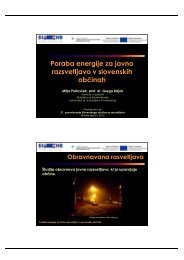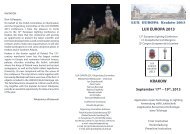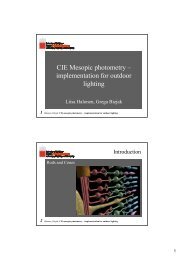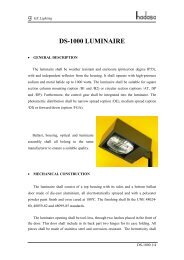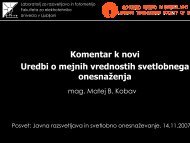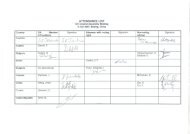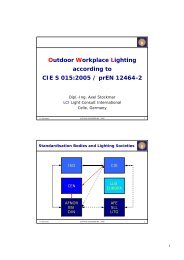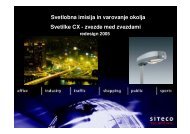Zbornik - SDR
Zbornik - SDR
Zbornik - SDR
Create successful ePaper yourself
Turn your PDF publications into a flip-book with our unique Google optimized e-Paper software.
“ Energy efficiency in INTERIOR Lighting – a Romanian Case Study ” R-3<br />
for standard fluorescent lighting installations varies from 13 to 20 W/m 2 . Recent progress in<br />
equipment and design demonstrates the possibility to reduce these values in the range of 7 to 10<br />
W/m 2 (Fontoynont, Escaffre & Marty 2002). A minimum acceptable lighting power density of about<br />
7 W/m 2 will leads to annual lighting consumption of 16 kWh/m 2 . Dimming or extinction of lamps of<br />
ambient lighting may lead to annual consumption below 10 kWh/m 2 (Fontoynont, Escaffre & Marty<br />
2002). Based on the few comprehensive estimates studies, there is stipulated an approximate<br />
commercial sector lighting savings potential in the range of 25% to 40% (Mills 2002). In practice<br />
savings will vary by country, depending on existing baseline conditions. Energy saving measures in<br />
lighting must be accepted by the users and must be associated with an improvement of their<br />
standards working condition, having in mind even the fact that the annual lighting consumption of an<br />
office worker is of the order of one hour of the his/her salary cost (Fontoynont, Escaffre & Marty<br />
2002).<br />
National building energy regulations. The legal frame for an energy efficient lighting approach is<br />
constituted by the general set of laws, referring to the whole building or energy consumer: • Law<br />
10/1995 “The Quality in Constructions Act” which establish the quality system, one of its<br />
compulsory regulations to be achieved and maintained during the entire life of construction referring<br />
to the law energy level of consumption and energy savings. • Law 199/2000 “The Energy Efficiency<br />
Act” according to the national policy on efficient use of energy, in conformity to the Energy Charta<br />
and Energy Efficiency and Environmental Protocol, which establish duties and stimulating measures<br />
for the energy producers and consumers regarding to its efficient use. The interior lighting<br />
installations are guided by two national recommendations – SR 6646-97 - Artificial lighting and NP-<br />
061-02 - Guide for design and execution of the buildings artificial lighting systems, following the<br />
CIE recommendations. Romanian norms include the recommended values of the illumination levels,<br />
maintenance factors and other parameters, but do not stipulate the specific requirement on energy<br />
efficiency for lighting equipment and systems, only the functional performance statement mentioned<br />
before: ‘to provide lighting systems which are energy efficient’.<br />
Energy aspects. The average electric energy consumption was 515 kWh/person in 2003. At the<br />
level of the EU, according to “Energy efficiency indicators in Europe” – Odysee [1], the residential<br />
consumption in 2003 was 2533 kWh/household/year. We remark that in Romania this consumption is<br />
of about 40% of the EU level (see Figure 3 a). There is currently no information with respect to the<br />
electric lighting use in offices.<br />
A measurement campaign at the local area in schools and offices (Pop&Beu 1998) stated a<br />
critical situation of the lighting systems, very old and out of right norms. Then, we promoted a long<br />
term information campaign through designers and building/electrical installations constructors, with<br />
the support of the national dealers and manufacturers, to improve their knowledge and to disseminate<br />
the results of the European programmes Thermie, Peco-Joule, Save.<br />
A questionnaire related with the energy efficiency in lighting was spread through the local area of<br />
the Lighting Engineering Center U.T.C.-N., at about 50 lighting designers and dealers, receiving<br />
back 30 of them (Pop 2003). The answers refer to the offices and small manufacturers. The installed<br />
specific power was in the range of 13–22 W/m 2 , and 3-5 W/m 2 /100 lx for offices, too higher than<br />
standard values. There was no correlation with the daylight availability and users needs/presence due<br />
to the lack of interest from the owners. Some designers did not know the infrared control system. The<br />
weighted factors (in a 1-3 scale) for lighting features were the following: • importance of the control<br />
facilities – individual or building central - 1, zones of activity - 3; • mention the specific power – 3; •<br />
high tech ballasts and lamps – 2 to 3; • mention/use of the proper lamps (efficiency, colour<br />
temperature, colour rendering index) – 3; • energy labels – 1; • maintenance schedule – 1; •<br />
photometric measurements – 1 to 2; • lighting installation history book – 1. The national norms were<br />
considered unsatisfactory to acceptable.<br />
“Lighting engineering 2006” stran 13



